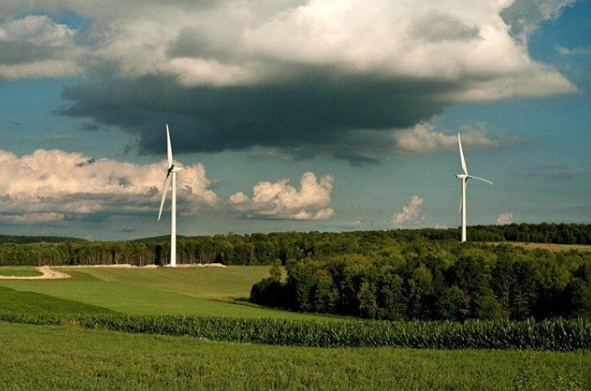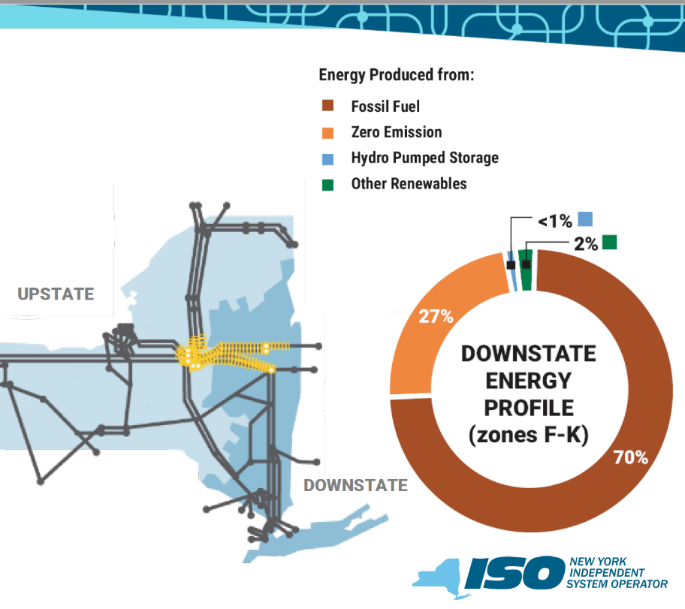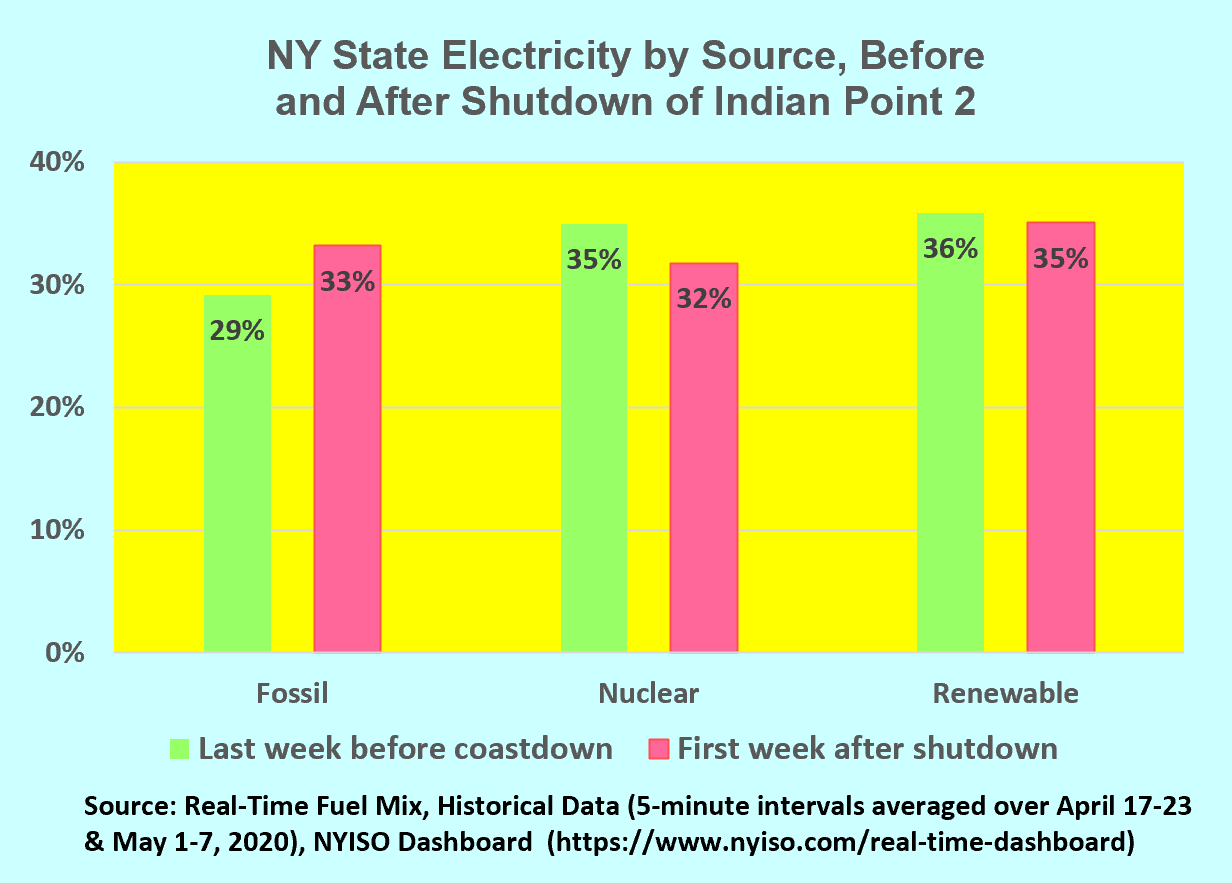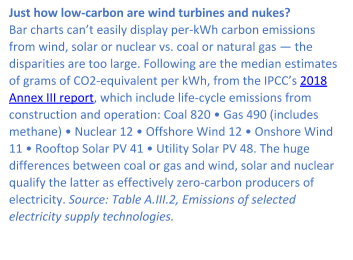
A New. York wind farm (photo: @nyserda)
Prologue
At the stroke of midnight, as April gave way to May, one hundred drones with diamond-brazed hacksaws descended on a remote section of the New York-New Jersey Bight. Methodically, diabolically, they set to their task: lopping off a thousand or more turbine blades whose spinning motion enabled the world’s biggest offshore wind farm. When the sun rose on May 1 it revealed a stark sight: 400 supertall towers stripped bare. Twelve hundred blades, three per tower, that for decades had funneled to the New York grid the equivalent of nearly a thousand megawatts of non-stop carbon-free power, lay at the bottom of the Atlantic.
No one noticed, at least not right away. Downstate New York homes, offices, and subways continued humming — at least, those not shuttered by the virus. The power grid summoned generators fired by natural gas piped in from Pennsylvania fracking sites that customarily ran at partial capacity. As they ramped up to full power their carbon emissions ramped up with them, magnifying New York’s climate impact even as officials were vowing to diminish it. While the worsened smog was concentrated in and around New York, the climate cost, in terms of worsened warming, would spread across the world.
OK, cut the fantasy. New York state’s hundreds of wind turbines are all upstate. None are offshore. In fact, there are just five in all east coast waters, all off Rhode Island. Moreover, hacksaws strong enough and drones sturdy enough to manage the dismemberment don’t yet exist; the turbine blades, toughened fiberglass dozens of feet across, would be hell to carve.
In real life, however, an equivalent operation — equivalent in its immediate climate consequences, that is — did commence at midnight on April 30, in a facility on the east shore of the Hudson River, 35 miles north of Columbus Circle. Technicians gingerly inserted boron rods into the core of the Indian Point #2 reactor, quenching the fissioning process that, since the mid-1970s, produced heat that boiled water that made steam that turned turbines and generated a large stream of carbon-free electricity.
That stream could be fickle. Over much of its first two decades IP2 was felled by leaks, cracks, and violations that limited its output averaged over a year to barely 50 percent of its nominal thousand megawatt capacity. Eventually, however, Indian Point 2, like most of the other 97 commercial reactors in the U.S., found a steady stride. At the end, the reactor was registering annual capacity factors of 80 percent or more and finally fulfilling the dream of trouble-free power.
Now it’s gone — its electricity, that is — switched off pursuant to a deal struck several years ago by plant owner Entergy, Hudson River watchdog Riverkeeper, and New York State, and endorsed by the state’s environmental and climate vanguard. The reactor’s twin sibling, Indian Point #3, will likewise go dark next April, doubling the loss of carbon-free output. From a climate standpoint the dual shutdown will be the same as erecting 800 giant wind turbines and then chopping off the blades.
Why Wind or Other Benign Energy Won’t Replace Indian Point’s Climate Contribution for Some Time
Wind turbines and reactors are dissimilar beasts. Wind turbines threaten no one, whereas the Indian Point nukes are thought by some to menace millions. Yet they have in common something vital to climate: neither entails a combustion process that emits carbon (or requires methane). This ensures that even counting their respective construction processes (and also, for the nukes, refueling), neither is responsible for more than a minuscule amount of greenhouse gases (see sidebar). Both are antidotes to fossil fuels.
Does it not follow, then, that shutting Indian Point need not worsen climate change? Can’t its nearly zero-carbon kilowatt-hours be replaced painlessly by building more wind or solar electricity, or with “negawatts” of electricity saved through energy-efficient L.E.D. lights and smarter appliances?
Riverkeeper and its anti-nuke allies take that stance in the case of Indian Point. I have advanced similar arguments repeatedly throughout my career.
Most recently, I have championed Mark Jacobson’s paradigm and analysis for replacing all energy— not just electricity — with “100 percent wind, water and sunlight.” Jacobson and his team concluded in 2013 that 40 percent of the energy required for New York State could be provided by 12,700 five-megawatt offshore wind turbines, with the remaining 60 percent coming from a mix of onshore wind, solar farms, rooftop solar on residential and commercial buildings, and retention of the state’s large hydro facilities built in the mid-20th century. I strongly endorse this vision and approach. And in a report published this week I documented that “clean electricity” — energy savings plus increased wind and solar power — is doing more than fracked gas to push out coal and decarbonize the U.S. electricity sector.
But even under the most optimistically aggressive timetables, it will be at least one decade and possibly several before it can be said that Jacobson’s turbines are doing Indian Point’s climate good deeds. That is because every bit of renewable energy and efficiency we can muster needs to go to replace fossil fuels, not to replace a different zero-carbon source. Not until the New York electric grid has been reconstituted to the point that the “replacement” (or “marginal” in the parlance of grid engineers and economists) block of power almost always comes from renewables rather than gas or coal can it be said that Indian Point’s climate benefit is now being supplied by solar or wind.
 The logic of electric grids dictates that if a block of carbon-free energy from, say, a giant wind farm, is having to replace similarly carbon-free Indian Point 2, it cannot also replace fossil fuels. Let's augment this point with two separate pieces of evidence pertaining to Indian Point.
The logic of electric grids dictates that if a block of carbon-free energy from, say, a giant wind farm, is having to replace similarly carbon-free Indian Point 2, it cannot also replace fossil fuels. Let's augment this point with two separate pieces of evidence pertaining to Indian Point.
First, the latest figures (2018) show that fossil-fuel plants supply downstate New York (New York City, Long Island, and the Hudson Valley) with 70 percent of its electricity, as per the donut chart below from the NY Independent System Operator, the state-chartered body that manages New York’s power grid. Moreover, because their fuel costs make them costlier to run, these plants, which are almost entirely fueled by natural gas, are always called on after the state’s renewable and nuclear sources. This guarantees that the “marginal” (last) units topping off the grid — the ones that will be fired up in place of Indian Point — are almost always gas-fired plants rather than zero-carbon generators.
In other words, shut Indian Point, and the flood of kilowatt-hours to replace it won’t come from existing wind or solar farms; these are already running as flat out as the available wind and sun permit. Until wind and solar (plus hydro and the state’s other operating reactors) so dominate the grid that one of them is always “next in line,” the energy replacing Indian Point will come from under-utilized fossil-fuel generators that will be made to run more than they would if Indian Point were still operating.
More proof, if any were needed, may be found in the bar chart below, which I derived from NYISO data. The bars contrast statewide electricity production during IP2’s final week at full power, before its “coastdown” en route to shutdown, with production in the first week without it.
The share of electricity produced by fossil-fuel plants shot up from 29% to 33%. Lest that rise seem small, those four percentage points actually denote a nearly 14 percent increase (the additional 4% share divided by the original 29%). A contributory factor was the small drop in renewables (largely hydro and wind), but most of the increase was a direct consequence of the fall in the nuclear share as Indian Point 2 was turned off.
It’s axiomatic: withdraw the nukes and fossil generation rushes in. (The same would happen if some state edict forced hydro plants or wind farms off line.) Reminder: Indian Point 3 is slated for shutdown next year.
Counter-arguments?
My argument, then, is that shutting Indian Point will result in a more or less one-for-one substitution of its output by climate-damaging fossil fuels, for a long period of time.
 Counterarguments range from somewhat wonky points about grid operation and management, to belief that with nuclear power diminished or off the table altogether, changes in culture and policy will enable energy efficiency and renewables to scale up faster. Some arguments and rejoinders follow:
Counterarguments range from somewhat wonky points about grid operation and management, to belief that with nuclear power diminished or off the table altogether, changes in culture and policy will enable energy efficiency and renewables to scale up faster. Some arguments and rejoinders follow:
Argument: Renewables won’t be throttled — deliberately cut back — as often if Indian Point isn’t supplying the grid; the regained output means that some of IP’s lost output is made up by wind and solar generation rather than fossil fuels.
Answer: Large-scale throttling of renewables in New York is a strawman, only occasionally befalling wind generators late at night when their output is high and demand is low, but accounting for less than 2 percent of statewide wind production. Moreover, nighttime loads appear poised to rise due to peak-pricing of daytime power, overnight charging of electric vehicles, and widespread development of energy storage systems, making throttling even more rare.
Argument: By pushing up prices paid for power supplied to New York, closing Indian Point will attract more renewables and efficiency.
Answer: That is true, but the likely effect will be far too small to offset the loss of Indian Point and bring much closer the time when the grid won’t have to run fossil fuel generators more than it would otherwise. (Note also that streamlining siting of wind and solar farms would probably spur renewables more than a modest jump in power prices; hopefully, the recently enacted Renewable Energy Growth and Community Benefit Act, REGACBA, will help accomplish that.)
Argument: Keeping Indian Point 2 alive was expensive.
Answer: That is true as well. Engineering, repairs, maintenance, security, regulatory compliance — the list is extensive. Still, these costs were largely known, and I strongly suspect that they were a relative bargain in terms of averted carbon emissions — at least compared to many other ways to cut carbon. (Building new reactors to cut CO2 is an entirely different proposition, of course.) Had IP2 been kept operating, any prospective major overhaul could have been an occasion for removing it from service.
Argument: Quebec’s vast hydro-electricity resources can readily substitute for Indian Point.
Answer: Bringing that power downstate presents a Rubik’s Cube of interlocking issues including cost, ownership, regulatory authority, and opposition not just from some First Nations and their environmentalist allies but also from competing electricity producers. And for all its vastness, Canadian hydropower too must be accountable to the reasoning that until the New York grid has been made largely carbon-free, every potential additional renewable kilowatt will be counted on to replace fossil fuels, and using it to replace another zero-carbon energy source effectively squanders its climate value.
Argument: Without Indian Point — indeed, without the distraction and false allure of nuclear power — society will be more inclined to throw its full weight behind renewables and efficiency.
Argument restated by a colleague: The question of Indian Point and carbon emissions is not some simple energy addition and subtraction but the social decision-making context. Everything is about politics — political and social will, messaging, energy, enthusiasm, public support. In the real world, enthusiasm for renewables is related to unease with nuclear power.
Answer: I agree that for far too long, nuclear power has absorbed far more public and policy attention than its current contribution and future potential warrant. (This report is an example!) It is also true that energy policy and investment are shaped by social context. But nuclear power’s heyday as a flashpoint of public concern was 40 years ago. Nowadays nuclear power isn't that much of a hot-button issue.
In short, the era is long gone when enthusiasm for renewables and the ability to harness it for a full-scale mobilization to rapidly push out fossil fuels was greatly influenced by unease about nukes. Rather, the two pillars on which a renewables-based Green New Deal will stand are, first, the immediacy of green jobs, and, second, the understanding — veneration, for some, myself included — that wind and solar, even at the necessary colossal scale, can be made harmonious with nature.
The argument also requires, as a kind of flip side, that leaving the 97 existing United States nuclear units running must enervate or undercut the push for renewables and energy efficiency. But how, exactly? I’ve no idea if this notion is widely held or just a niche affectation. But if it is to rise beyond hand-waving, its adherents should at least identify the flashpoints and levers by which clinging to existing reactors is getting in the way of massively expanding solar and wind.
What about radiation dangers from Indian Point?
The main purpose in closing the Indian Point reactors — and, arguably, the reason New York’s governor took an interest — is of course to extinguish the possibility of exposing the tens of thousands of people in its immediate vicinity and the millions in the New York metropolitan area, many of whom cannot quickly evacuate, to radioactive contamination from an accident on the scale of Chernobyl in 1986 or Fukushima in 2011.
Since the dawn of U.S. commercial nuclear power in the late 1950s, the nuclear industry’s bête noire has been the specter of horrific accidents, not least because it motivated increasingly stringent safety requirements that in turn drove up costs. I know very well the safety-regulation-cost nexus. In the early 1980s I published a scholarly article on the subject in the peer-reviewed journal Nuclear Safety, followed by a book-length exploration, Power Plant Cost Escalation: Nuclear and Coal Capital Costs, Regulation and Economics, arguing that costs arising from ever-increasing regulatory stringency would doom nuclear power’s expansion in the United States.
No one can divine the likelihood of a serious accident at Indian Point, particularly as it hinges in part on human fallibility and malfeasance. Nevertheless, I believe that if I lived nearby I would draw some comfort from the absence of a severe U.S. reactor accident in the four decades since the 1979 meltdown of the Three Mile Island reactor near Harrisburg, PA. Since that traumatic event, U.S. nuclear plants have racked up roughly 15 times as much experience as they had accumulated to that time.
This points to some success in climbing out of the morass of design blunders and operational mishaps that so unsettled Americans about nuclear power in its first few decades. So does the sharp reduction in reactors’ average downtime rates from 40 percent to 15 or even 10 percent today — an achievement that can’t entirely be chalked up to lax regulation.
This brief argument will not resonate with those who regard every reactor on earth including Indian Point as a bad accident waiting to happen. Nor do I intend it to. Here I am seeking to lay to rest the notion that the decarbonization lost by shutting Indian Point can be made up elsewhere anytime soon. It cannot, for the reason that those “elsewhere” decarbonization candidates — huge wind farms, wholesale installation of solar arrays, and energy efficiency for which I and others have campaigned for half a century — are all needed to push out fossil fuels. If any of these measures are replacing Indian Point, they’re not decarbonizing.
Riverkeeper and Indian Point
The campaign to shut Indian Point has been spearheaded by the venerable Hudson River environmental watchdog group Riverkeeper. Founded in 1966 as the Hudson River Fishermen’s Association, Riverkeeper earned its environmental stripes exposing and litigating corporate polluters and tenaciously defending the lower Hudson Valley and New York region’s drinking water and overall ecology. Its push to shut Indian Point was borne from the harm to the Hudson’s renascent striped bass fishery from the plant’s thermal plumes, impingement, and entrainment. Riverkeeper also has been the template for numerous “waterkeeper” protectors around the country. I’m a former member of the group and also consulted for it on several earlier efforts to shut Indian Point.
At the time of this writing, the group’s web site is marking the shutdown of Indian Point 2 with a statement referring to “this historic moment” and noting:
As Indian Point shuts down, environmental groups…are emphasizing the fact that renewable energy and energy efficiency that has been built up over the last several years are replacing the energy from Indian Point. An independent research brief by Physicians, Scientists, and Engineers for Healthy Energy found that recent deployment, current development, and projected growth of renewable generation and energy efficiency will contribute nearly 45,000 GWh annually by 2025, almost three times the 16,000 GWh currently supplied by Indian Point. (emphases added)
The brief cited by Riverkeeper is actually more guarded on these points. Its conclusion begins:
Our estimates suggest that renewables, storage and energy efficiency growth in line with New York’s targets could provide sufficient generation and local capacity following Indian Point’s closure, avoiding the need for a sustained increase in gas generation. (emphases added)
Note “could” rather than “will” and “sustained” rather than “any,” suggesting not just hedging by the consultant but some concordance with my central point that for years to come, climate-damaging carbon emissions will be higher without Indian Point operating than they would be with it. Indeed, the consultant’s brief did not venture such a comparison — suggesting that the scope of work from Riverkeeper may have excluded evaluating the possible rise in greenhouse gas emissions from shutting the reactors.
The consultant’s brief is creditable. It doesn’t invoke speculative imports of hydropower from Quebec. It explicitly and repeatedly credits “Indian Point’s carbon-free generation,” thus steering clear of outdated anti-nuclear tropes of reactor operation as somehow carbon-intensive. Most importantly, the brief does not claim that retiring Indian Point will leave the climate unscathed.
Coda
It is likely too late to reverse the shutdown of Indian Point 2. Too much went into crafting the deal, and too many plans have built on the expectation that the plant is being closed. The same, it must be said, goes for Unit 3.
In addition, with closure now the status quo, its reversal likely would be seen as, and thus would become, the kind of shot in the arm for nuclear power that could, in fact, get in the way of energy efficiency and renewable energy, just as the antinukers fear.
So the closures of Indian Point 2 and 3 will almost certainly stand. Why write this report, then? I could say I was forced to. First, by an anti-closure supporter of my not-for-profit, the Carbon Tax Center, who bared his distress to me and said that my silence made me complicit in setting back the climate cause. I came to agree that I was complicit — though not as director of CTC but as someone with the capacity to look clear-eyed at the issue, based on my long study of nuclear power and energy policy. I soon concluded that my long-standing excuse for being silent — Well, if New York state and the federal government had enacted the kind of carbon taxing I’ve fought for, Indian Point’s carbon benefits would be monetized —as they deserve to be — and that would have thwarted and defeated the long-standing campaign that did finally shut it down. — was insufficient.
I have little axe to grind here. I believe I see all sides. Unfortunately, the climate side, which moves me most, was not at the table when the deal was hammered out in 2016. The argument that renewable energy and energy efficiency can replace Indian Point, which originally was simply meant to cover — which it in fact does — keeping on the lights without laying too big of an economic egg, was too casually and carelessly extended to say that renewable energy and energy efficiency will replace Indian Point’s climate benefits, which they cannot do for quite some time.
Why climate was not at the table when Indian Point’s fate was being sealed is a worthy subject, perhaps for another occasion. I hope readers find this paper illuminating and helpful.
***
Charles Komanoff, a mainstay of New York City's livable streets movement, had an earlier career as author, researcher, and expert witness on electricity policy and nuclear power. On Twitter @Komanoff.
***
Have an op-ed idea or submission for Gotham Gazette? Email This email address is being protected from spambots. You need JavaScript enabled to view it.





